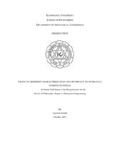Please use this identifier to cite or link to this item:
http://archive.nnl.gov.np:8080/handle/123456789/433| Title: | Study on sediment characterization and its impact on hydraulic turbine material |
| Authors: | Poudel, laxman |
| Keywords: | Hydraulic turbine Sdiemnts Mineral |
| Issue Date: | 26-Feb-2018 |
| Abstract: | Erosion on hydraulic turbine by sediments is one of the major problems and is complex in nature. Sediment characteristics are important parameters to be considered while measuring its effect in turbine material. This study is done to understand sediment characteristic according to its size, shape and mineral content. Four different rivers of Nepal were chosen to analyze sediments according to size, shape and mineral content. Roshi River was chosen as the principal river and furthermore Indrawati, Sunkoshi and Modi rivers sediments were studied. Sieve analyzer, image processing and acid wash techniques were used to characterize sediment particles according to its size, shape and mineral content. It was observed that bigger the sediment size greater is the effect. It was also depicted that twenty one different sediment shapes can be traced out and its abundance can be studied using image processing technique. It is found that greater the sediment quantity greater is the erosion impact. An angular shape particle yields in high amount than the irregular one. Irregular shapes sediments are more abundant in upstream of the river and slowly changes to less spherical and round shape sediments while travelling to downstream part of the river. So it can be idealized that sand particles shapes changes while being transported due to interaction with each other and changes from its original shape to more round. It is found that circular with low sphericity sediment shapes are most abundant in rivers followed by circular with high sphericity, elongated, square and triangular. Triangular particles are present in very low amount compared to other shapes. In general Irregular shapes have more erosion potential than regular shapes. It was also observed that the particles with the irregular shape of smaller size induce higher erosion rates than that of the larger size with the same shape. Mineral content is another parameter of sediment which was analyzed using acid wash technique. It was observed that quartz is the most dominating content available that has high eroding value followed by feldspar, mica and other minerals. The other mineral refers to carbonates, clay, chlorite and fragment of dolomite, calcite, shale, tourmaline, hornblende, garnet and many hard and soft minerals. These findings will help to select the proper site of a power plant in erosion prone basins and would also help to design suitable settling basins to trap sediment particles having higher erosion potentials. Furthermore this study will be helpful for water quality monitoring, determining the proper spot for hydro power generation and irrigation, wastewater treatment area and many more. A database obtained can be used to train by neural network which can clearly distinguish the particles in depth like if the particle is sand it can be further classified as mica, quartz, feldspar, amphibole, biotite etc which can put a great leap in sediment classification and impact study. |
| Description: | Dissertation submitted in partial fulfillment of the requirements for the Doctor of Philosophy Degree in Mechanical Engineering, School of Engineering, Department of Mechanical Engineering, Kathmandu University, 2013. |
| URI: | http://103.69.125.248:8080/xmlui/handle/123456789/433 |
| Appears in Collections: | 600 Technology (Applied sciences) |
Files in This Item:
| File | Description | Size | Format | |
|---|---|---|---|---|
| Thesis_Final_10-29.pdf | 9.65 MB | Adobe PDF |  View/Open |
Items in DSpace are protected by copyright, with all rights reserved, unless otherwise indicated.